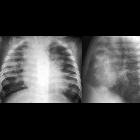Surfactant-Mangelsyndrom

Ösophagusatresie
Typ II nach Vogt: Oberer Blindsack kontrastiert. Luftleeres Abdomen somit keine Verbindung / Fistel zum Tracheobronchialsystem. Zusätzlich Atemnotsyndrom.

Premature
newborn with respiratory distress on a ventilatorCXR AP shows a large amount of lucency in the right pleural space and there is mediastinal shift to the left.The diagnosis was a right tension pneumothorax in a patient with respiratory distress syndrome.

The
crazy-paving pattern: a radiological-pathological correlation. Acute respiratory distress syndrome. CT revealed bilateral areas with ground-glass attenuation superimposed with a reticular pattern. These lines corresponded to thickening of the interlobular septa, but also thickening of the intralobular interstitium
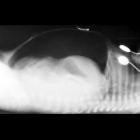
Premature
newborn with respiratory distress syndrome and new abdominal distension on a ventilatorAXR cross-table lateral shows a distended abdomen with a huge amount of air between the anterior abdominal wall and the abdominal organs.The diagnosis was pneumoperitoneum in a patient with respiratory distress syndrome.

Premature
newborn with respiratory distress on a ventilatorCXR AP (above) shows a large amount of air around the heart. CXR AP obtained after pericardiocentesis (below) shows a decreased amount of air around the heart and the diaphragm can be continuously traced across the image.The diagnosis was pneumopericardium in a patient with respiratory distress syndrome.

Respiratory
distress syndrome • Respiratory distress syndrome - Ganzer Fall bei Radiopaedia

Respiratory
distress syndrome • Severe respiratory distress syndrome (RDS) - Ganzer Fall bei Radiopaedia

Premature
newborn with respiratory distressInitial CXR shows low lung volumes and symmetrical (apex to base as well as left to right) ground glass opacity in both lungs.The diagnosis was respiratory distress syndrome (also known as hyaline membrane disease and surfactant deficiency disorder).

Premature
newborn with respiratory distressCXR AP shows the lungs to be hypoexpanded with symmetrical ground glass opacity present throughout the lungs from their apex to their base.The diagnosis was respiratory distress syndrome.
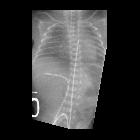
Premature
newborn after umbilical catheter placementCXR AP shows the tip of the umbilical venous catheter within the right portal vein. The tip of the umbilical arterial catheter is at T5. There is ground-glass opacity in the lungs.The diagnosis was low malposition of the umbilical venous catheter and high malposition of the umbilical arterial catheter in a patient with respiratory distress syndrome.

Premature
newborn after umbilical venous catheter placementCXR AP shows the tip of the umbilical venous catheter projecting over the left portal vein. The tip of the umbilical arterial catheter projects at T6. There is hazy ground glass opacity in the lungs.The diagnosis was low malposition of the umbilical venous catheter and appropriate position of the umbilical arterial catheter in a patient with respiratory distress syndrome.

Acute
respiratory distress syndrome • ARDS secondary to Tiger snake bite - Ganzer Fall bei Radiopaedia

Premature
newborn after placement of two umbilical arterial cathetersSupine and cross-table lateral AXR shows the tip of one umbilical arterial catheter to be at T6 and the tip of the other umbilical arterial catheter to be at L1. Note on these images how after insertion at the umbilicus the umbilical arterial catheters first head caudad in the umbilical artery and internal iliac artery before heading cephalad in the common iliac artery and aorta. There is faint ground-glass opacity in the lungs.The diagnosis was normal position (at T6) and low malposition (at L1) of the umbilical arterial catheters in a patient with respiratory distress syndrome.
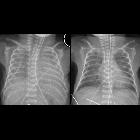
Premature
newborn who has received artificial surfactantCXR AP obtained just after birth (left) shows the lungs to be hypoexpanded with symmetrical ground glass opacity present throughout the lungs from their apex to their base. CXR AP taken after the administration of artificial surfactant (right) shows the lungs to now be normally expanded with symmetrical clearing of the previously seen ground glass opacity present throughout the lungs.The diagnosis was symmetrical distribution of artificial surfactant in a patient with respiratory distress syndrome.
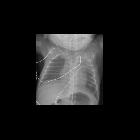
Premature
newborn after umbilical arterial and umbilical venous catheter placementCXR AP shows the tip of the umbilical arterial catheter to be in the left subclavian artery. The tip of the umbilical venous catheter is deep within the right atrium. The lungs show minimal ground-glass opacity.The diagnosis was high malposition of the umbilical arterial catheter and high malposition of the umbilical venous catheter in a patient with respiratory distress syndrome.

Premature
newborn with respiratory distressCXR AP shows an endotracheal tube with its tip projecting deep within the right mainstem bronchus. There is partial atelectasis of the right upper lobe with no mediastinal shift. There are diffuse ground glass opacities present throughout the lungs.The diagnosis was an endotracheal tube positioned too deep in the right mainstem bronchus along with respiratory distress syndrome.
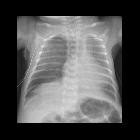
Premature
newborn after chest tube placementCXR AP shows diffuse ground glass opacity throughout the lungs and a large amount of air in the right pleural space causing mediastinal shift to the left while the right-sided chest tube courses through the subcutaneous tissues of the right chest wall and never enters the right pleural space.The diagnosis was persistent pneumothorax in a patient with respiratory distress syndrome due to the chest tube tip not being in the pleural space.

Acute
respiratory distress syndrome • Acute respiratory distress syndrome (ARDS) - Ganzer Fall bei Radiopaedia

Acute
respiratory distress syndrome • Adult respiratory distress syndrome - Ganzer Fall bei Radiopaedia

Premature
newborn who has had 2 umbilical venous catheters placedCXR AP shows the tip of one umbilical venous catheter to be in the superior vena cava with the tip of the other umbilical venous catheter curled within the right atrium. The tip of the endotracheal tube is in the right mainstem bronchus. The lungs have ground-glass opacity.The diagnosis was high malposition of the umbilical venous catheters and malposition of the endotracheal tube in a patient with respiratory distress syndrome.

Premature
newborn who has become more difficult to ventilateCXR AP shows a branching bubbly appearance to the right lung along with air in the superior mediastinum.The diagnosis was pulmonary interstitial emphysema and pneumomediastinum in a patient with respiratory distress syndrome.

Premature
newborn who has just been intubatedCXR AP shows an endotracheal tube with its tip projecting beneath the carina and not over either mainstem bronchus and a distended stomach. There are diffuse ground glass opacities present throughout the lungs. CXR lateral shows the endotracheal tube to be posterior to the trachea and in the esophagus. The diagnosis was esophageal intubation along with respiratory distress syndrome.

Respiratory
distress syndrome • Respiratory distress syndrome - Ganzer Fall bei Radiopaedia

Respiratory
distress syndrome • Hyaline membrane disease - Ganzer Fall bei Radiopaedia

Premature
newborn with respiratory distress on a ventilatorCXR AP shows a large amount of lucency in the left lung base and over the left hemidiaphragm with a chest tube in the center of it.The diagnosis was a basilar pneumothorax in a patient with respiratory distress syndrome.
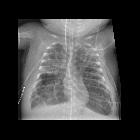
Premature
newborn with respiratory distress on a ventilatorCXR AP shows a large amount of lucency in the lung bases bilaterally while the cardiac silhouette is very narrow and small in size. The mediastinum remains in the midline.The diagnosis was bilateral tension pneumothoraces confirmed after bilateral chest tube placement in a patient with respiratory distress syndrome.

Premature
newborn who has received artificial surfactantCXR AP obtained just after birth (left) shows the lungs to be hypoexpanded with symmetrical ground glass opacity present throughout the lungs from their apex to their base. CXR AP taken after the administration of artificial surfactant (right) shows the right lung to now be normally expanded with clearing of the previously seen ground glass opacity while the left lung remains hypoexpanded with asymmetrical ground glass opacity present throughout it.The diagnosis was asymmetrical distribution of artificial surfactant in a patient with respiratory distress syndrome.

Acute
respiratory distress syndrome • COVID-19 - rapidly progressive acute respiratory distress syndrome (ARDS) - Ganzer Fall bei Radiopaedia

Respiratory
distress syndrome • Hyaline membrane disease - Ganzer Fall bei Radiopaedia

Respiratory
distress syndrome • Neonatal respiratory distress syndrome, pneumothorax, and PICC line malposition - Ganzer Fall bei Radiopaedia

Premature
newborn with respiratory distress on a ventilatorCXR AP+lateral shows air around the thymus superiorly and air around the heart inferiorly. The diaphragm can be traced continuously across both images. There is also a small amount of air in the apex of the right pleural space.The diagnosis was pneumomediastinum and a small right apical pneumothorax in a patient with respiratory distress syndrome.

Premature
newborn with respiratory distress on a ventilatorCXR AP (above) shows symmetrical ground glass opacity in the lungs. CXR AP obtained after decreasing ventilator settings (below) shows interval decreased aeration of the right upper lobe.The diagnosis was atelectasis caused by hypoventilation in a patient with respiratory distress syndrome.

Respiratory
distress syndrome • Respiratory distress syndrome - Ganzer Fall bei Radiopaedia

Respiratory
distress syndrome • Respiratory distress syndrome - Ganzer Fall bei Radiopaedia

Respiratory
distress syndrome • Respiratory distress syndrome - Ganzer Fall bei Radiopaedia

Respiratory
distress syndrome • Respiratory distress syndrome with misplaced nasogastric tube - Ganzer Fall bei Radiopaedia

Respiratory
distress syndrome • Respiratory distress syndrome - Ganzer Fall bei Radiopaedia
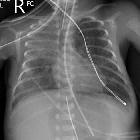
Respiratory
distress syndrome • Respiratory distress syndrome - Ganzer Fall bei Radiopaedia

Premature
newborn with respiratory distress. CXR shows air branching throughout the pulmonary interstitium in the left lung.The diagnosis was left-sided pulmonary interstitial emphysema in a patient with respiratory distress syndrome.
 Assoziationen und Differentialdiagnosen zu Surfactant-Mangelsyndrom:
Assoziationen und Differentialdiagnosen zu Surfactant-Mangelsyndrom:







